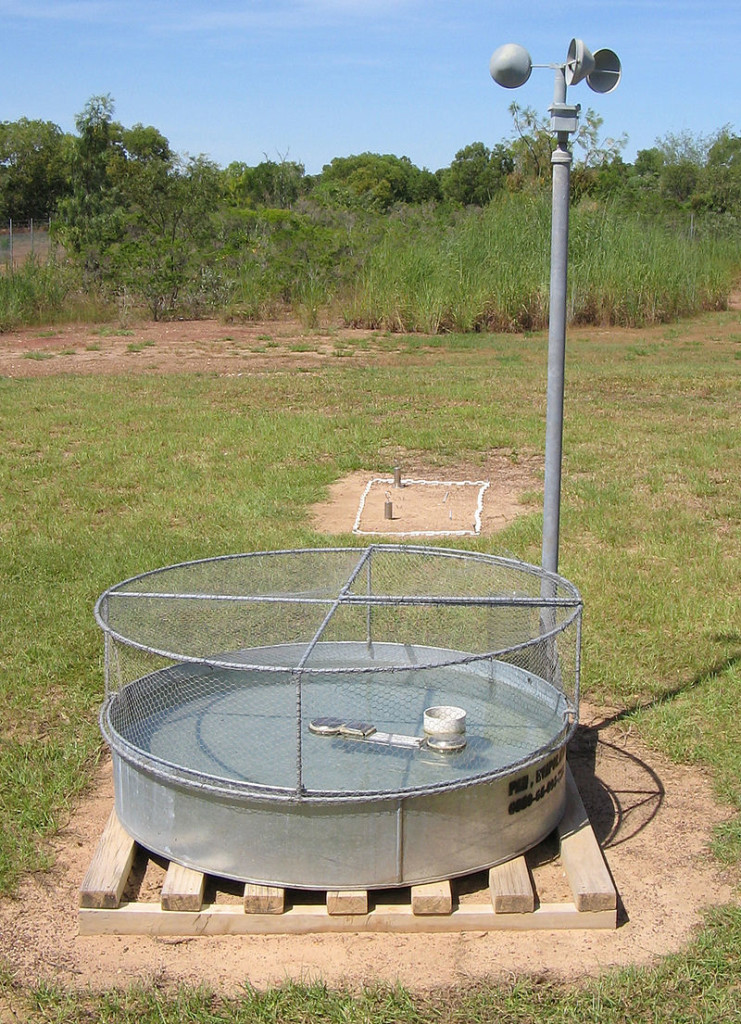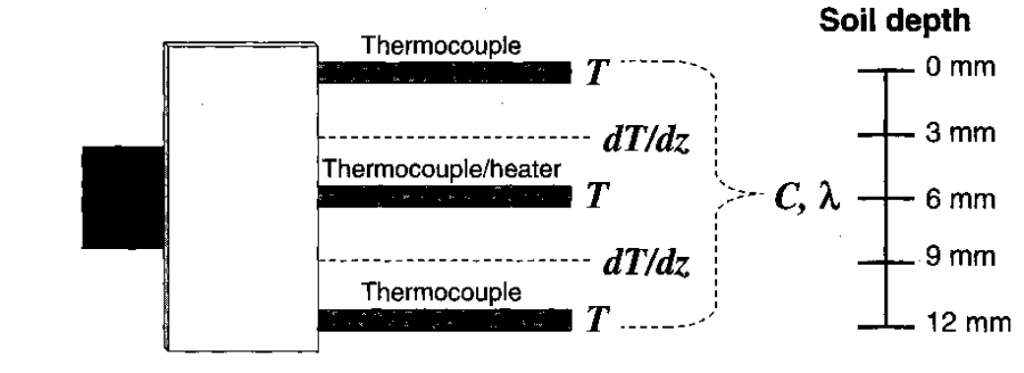Evapotranspiration is often said to be the most difficult water balance component to directly measure. When water goes from liquid to vapor, you can’t exactly catch it in a bucket or measure flow in a channel. In my Watershed Hydrology class, we used a very simplified version of the weighing lysimeter to measure evapotranspiration from soils and potted plants. But how else can we measure evaporation and transpiration? Let’s start by talking about techniques used to measure evapotranspiration from particular surfaces (open water, soil, plant interiors (transpiration), and plant surfaces (interception)).
1. Open Water Evaporation
As we talked about in class, open water evaporation is first and foremost a function of the availability of energy (i.e., net radiation) at the water surface and the ease with which water vapor can mix into the atmosphere (i.e., humidity, wind). But properties of the water body also matter, including water depth, thermal stratification, size, heat content of inflows and outflows, vegetation (shading), turbidity and bottom reflectance (albedo), and salinity. Unfortunately, those variable water body properties make it a harder to get evaporation than it would be if it were solely energy, wind, and humidity.
If you want to measure lake evaporation, one approach is to measure all of the other hydrologic cycle components for the lake, including change in lake level for your change in storage. Then solve for evaporation, using the water balance.

Example of the components needed for a lake water balance. This image is from the USGS, http://pubs.usgs.gov/wri/wrir-03-4238/ and is in the public domain.
If the water balance approach is not practical, you can measure the water balance of a very simplified system called an evaporation pan. Here’s how a standard (class A) evaporation pan works. The pan is 122 cm in diameter and 25 cm deep. It’s placed outside in an area free of obstructions and water level is maintained at 18-20 cm deep. The water is refilled as needed to maintain the desired level. Water level measurements are taken daily (giving evaporation as a depth) or the volume of water required to refill to the desired level is recorded (volume of added water divided by area of pan = evaporation as depth). Of course, since the pan is outside, it will also receive rainfall, so that needs to be measured and figured into the calculations:
Evaporation = beginning depth – ending depth (for days with no rain)
Evaporation = beginning depth – ending depth – rainfall depth (for days with rain)
Since a shallow pan evaporates more quickly than a deeper lake, to get lake evaporation you multiply the pan evaporation rate from the pan by a lake coefficient (typically 0.7 to 0.75) that takes that into account.

A Bureau of Meteorology (Australia) class A evaporation pan, with an adjacent anemometer to measure wind speed. A rain gauge would also be located nearby. This file is licensed under the Creative Commons Attribution 3.0 Unported license from Wikimeida. Image by Bidgee.
2. Soil evaporation
The conceptually simplest way to measure soil evaporation is the weighing lysimeter, as long as your lysimeter doesn’t contain any vegetation. (The group who used the pots with soil and mulch was measuring soil evaporation in this approach.) The weighing lysimeter takes advantage of a mass balance approach to the water balance.
Another method takes advance of a heat balance. In this technique, fine scale measurements of soil temperature and thermal properties are used to calculate change in sensible heat storage at different depths from the soil surface. Over short distances and time scales, sensible heat changes as a function of latent heat (i.e., evaporation).
Measurements are made with carefully spaced thermocouples (i.e., thermometers). One of the thermocouples also has a heating element, that can send out pulses of heat. By measuring how those heat pulses are received at different distances, the latent heat can be calculated.

Heat pulse sensor and associated measurements. Temperature (T), temperature gradient (dT/dz), volumetric heat capacity (C), and thermal conductivity (I) are the relevant variables. From Heitman et al., 2008, Water Resources Research.
You can read a lot more about the details of the method and math in Heitman et al., 2008, Water Resources Research, which is freely available. The diagram above shows how the apparatus works. Looking ahead, this approach is very similar to how sapflow in trees is measured to estimate transpiration.
3. Transpiration (evaporation from plant interiors)
Transpiration – or evaporation from the leaves and needles of vegetation – is really important in many landscapes. You’ve already experienced one approach to measuring it – our variation on the weighing lysimeter – with our potted plant experiments.
Measuring the change in weight of potted plants is a tried-and-true approach to estimating transpiration – especially if care is taken to reduce soil evaporation (think mulch or some sort of plastic sheeting). But there are limits on how big a plant you can put on a scale and larger weighing lysimeters can be very expensive to build and maintain. Even then, you don’t find many weighing lysimeters measuring full grown oak or fir trees! So other approaches are needed.
An approach that works with plants up to large shrubs or small trees is the tent method. Here the plant is enclosed in a clear plastic tent and the moisture content of the air entering and leaving the tent (via fans) is measured. When the moisture content of the air leaving the tent is higher than the air entering the tent, that’s because of evapotranspiration. And if the soil surface is covered, the difference in moisture is just due to transpiration. BUT! It gets hot inside the tent so maintaining proper air flow is critical. Even so, the transpiration rates measured using the tent method might not be the same as would occur in the surrounding natural environment.

Illustration of the tent method for measuring evapotranspiration. Figure 4.5 in Brooks et al., 2012, Hydrology and the Management of Watersheds (your textbook).
A smaller, shorter-term variation on the tent method is porometry – which measures stomatal conductance. In porometry, a leaf is temporarily enclosed in a small chamber where changes in humidity are measured – and attributed to transpiration. Porometry is good at telling scientists how stomata are responding to environmental variations at really small scales, but isn’t good at providing larger scale data, because what the stomata are doing can vary depending on the orientation of the leaves, height in the tree, etc. Age of the plant, plant species, etc. also effect how stomata respond to environmental conditions – and that’s before you even get to the environmental variations themselves (temperature, humidity, wind, etc.). So you would need to make a LOT of stomatal conductance measurements via porometry to use this approach to accurately measure transpiration for large plants, like trees, for example. Nonetheless, it’s a pretty cool technique that can tell you a lot about how plants are taking up and releasing water. Here’s a video that explains more about how it works:
So if porometry, tenting, and weighing lysimeter style measurements are all limited to small plants, how the heck do you measure transpiration in larger trees? After all, in forested environments, they are going to be doing a lot of the transpiration we’re interested in. The answer is sap flow measurement, and here are two videos that explain what it is and how it works. The first video gives you a quick and simple explanation, while the second video is full of information and even shows example data!
4. Interception (evaporation from plant surfaces)
Interception is the precipitation that never makes it to the soil surface because it gets hung up on leaves and branches of vegetation or even the dead organic material on the forest floor (the litter). After the storm is over, this water evaporates before it ever reaches the ground. That process of being caught then evaporated is called interception. Interception can be a very important water balance term, in both the winter and summer. (I’ve written more about snowfall interception here.)
The simplest way to measure interception is to measure the precipitation in an open area and compare to precipitation measured under the forest canopy (through fall) and what runs down the stems of trees (stemflow). Interception is the difference. This ignores litter interception though and that’s a bit harder to measure. There are also some really cool new techniques demonstrated in the video below, that let researchers start to scale up from point measurements to a whole forest:



Nice plan for content warnings on Mastodon and the Fediverse. Now you need a Mastodon/Fediverse button on this blog.